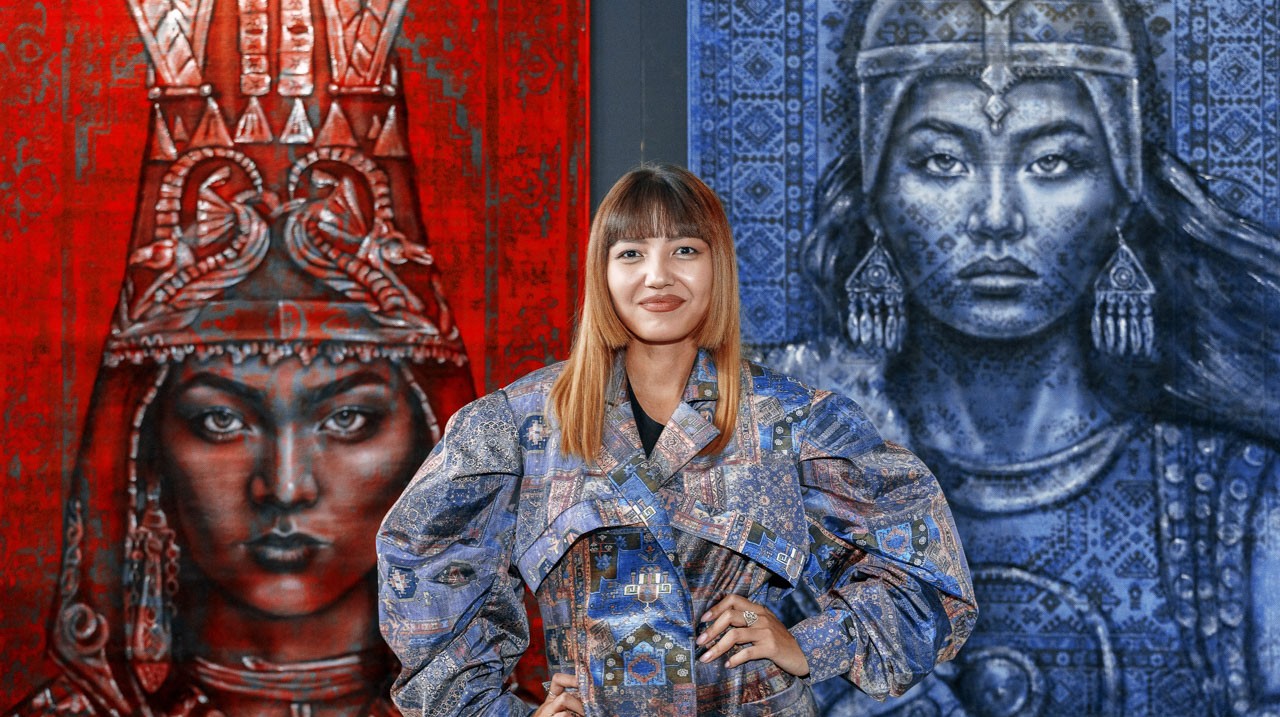ASTANA – Kazakh artist Assel Sabyrzhankyzy has gained widespread attention on social media with her distinctive works, where tradition meets street art, and carpets replace the canvas. In an interview with The Astana Times, Sabyrzhankyzy revealed that her artistic language was born from a desire to connect the past and the present.
Sabyrzhankyzy during her exhibition at the Forte Kulanshi Art Space in Astana. Photo credit: Forte Kulanshi Art Space
For the Turkic people, the carpet carries sacred meaning. It is more than a household item. It is an element of memory and identity, a woven reflection of national culture.
“I grew up surrounded by carpets, ornaments, and stories deeply rooted in tradition. Over time, I realized that these traditional symbols should not remain in the past – they need a new approach. Now, I translate them into the language of contemporary art, through video, social media, texture, scale, and emotion. For me, it’s a way to show that culture is alive and evolving, and can remain relevant if we speak about it sincerely and with love,” said Sabyrzhankyzy.
Her passion for drawing began in childhood. Even in kindergarten, teachers noticed her love for details.
“When I was a teenager, I won an international art competition organized by Ernst & Young. I received both the Grand Prix and first prize. Two of my paintings were sent to London, and I received $1,000. That moment gave me confidence, and I firmly decided to become an artist,” she said.
Her first professional work, she noted, was a portrait of her maternal grandmother, created while she was studying at an art school. “It turned out so realistic that my whole family was amazed, and so was I,” she said.
Discovering her voice
Kazakh artist Assel Sabyrzhankyzy painted an image of Kok Borі, the legendary mother wolf of the Turkic peoples. Photo credit: assolyaa Instagram page
Sabyrzhankyzy noted that her journey toward painting on carpets was gradual and filled with experimentation. She tried painting on T-shirts, wooden bars, and even on a dombra before finding her unique medium.
“One day, I asked my husband to buy a carpet and painted an image of Kok Borі, the legendary mother wolf of the Turkic peoples. As soon as I started painting on it, I realized that this was truly mine,” she said.
Since 2021, Sabyrzhankyzy has been posting creative videos on TikTok and Instagram, gaining a large following for her vivid visual storytelling.
Working on each painting, she said, is a labor-intensive process that begins with finding the right carpet and developing a meaningful sketch.
“The hardest part is coming up with a sketch that carries a story and looks beautiful. I need to read a lot and collect visual references. Then comes the task of finding a carpet that matches the composition in pattern and color. Sometimes, I have to visit 20 to 25 stores to find the right one,” she said.
Sabyrzhankyzy noted that one mistake on a carpet can ruin an entire piece.
“There’s no room for error, one wrong stroke on a carpet and the paint will not come off. At the same time, I have to make sure everything looks beautiful on camera,” she said.
Reviving the image of Turkic women
The images of Turkic women hold a central place in Sabyrzhankyzy’s art. In 2023, she presented 15 carpet paintings at the Forte Kulanshi Art Space in Astana.
“My mission is to revive the true meaning of Turkic womanhood. These women became my way of speaking about our roots and the inner strength passed through generations. I wanted to portray them not just as symbols, but as living energy – the force that shaped culture and inspired others,” she said.
Her series, “Women of the Great Steppe,” included prominent figures such as Tomiris, Bopai, Aiganym, and Aibike Batyr, among others.
“After the exhibition, I understood how close carpets are to our culture. They once decorated yurts, were gifted to respected people, and in Soviet times, they hung on our walls,” she said.
Sabyrzhankyzy believes the role of women in Kazakhstan’s contemporary art scene has become more visible and self-defined. According to her, female artists shape the artistic agenda by exploring themes of identity, memory, language, and tradition, and by integrating them into the global art scene.
“We are no longer just muses or someone’s subject. We are authors, curators, researchers, and entrepreneurs. I admire how Kazakh female artists combine craft and concept, the local and the modern, not for conflict, but for depth and dignity,” she said.
Bridging cultures
Jackie Chan and Assel Sabyrzhankyzy. Photo credit: assolyaa Instagram page
Sabyrzhankyzy’s carpets have also connected her with international celebrities. Recently, she created portraits of Jennifer Lopez and Jackie Chan during their visits to Kazakhstan.
“When Jennifer Lopez came to Astana for her concert, her energy and charisma inspired me to reflect that through art. She even reposted my work on her Instagram. It was unbelievable! I’m so grateful to her. She’s a generous, big-hearted person,” said Sabyrzhankyzy.
“During Jackie Chan’s visit, I realized he was more than a movie star, he was a cultural bridge. My painting became a tribute to his life journey, his persistence, and his talent. Seeing his reaction, smiling and surprised that it was a real carpet, filled me with joy and a sense of responsibility. For me, it is not just a gift, it is a dialogue with the global world,” she said.
For Sabyrzhankyzy, the most inspiring part of her work is seeing the finished result and receiving support from her audience.
“The feedback from my followers gives me huge motivation. Their heartfelt comments fill me with energy to keep creating. I am also inspired by collectors who treat my works with such love and respect. I love the people of our country – they inspire me every day,” she said.





